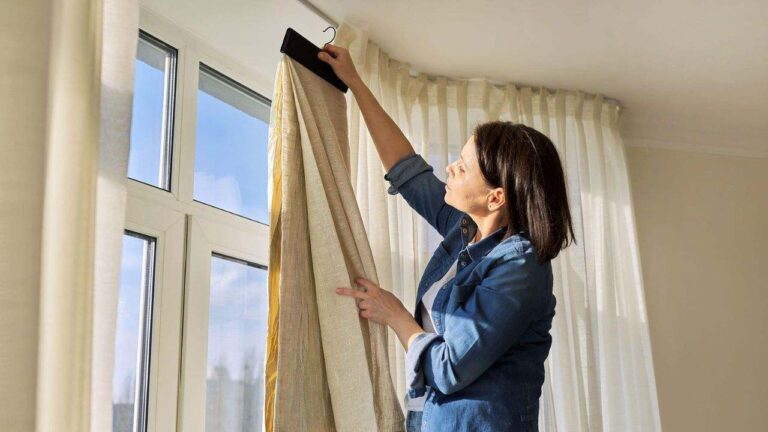Ever open your electricity bill during peak summer and feel your stomach drop?
Energy costs just keep climbing. And here’s something that might surprise you: your windows are probably responsible for up to 30% of what you’re paying to heat and cool your home.
According to the U.S. Department of Energy, windows account for 25 to 30 percent of residential heating and cooling costs.
The solution isn’t always replacing windows. Sometimes it’s about what you put over them.
Modern window treatments, especially motorized window treatments, offer homeowners a practical way to cut energy costs without major renovations.
Why Your Windows Are Costing You Money
Think about it this way.
During summer, your windows are basically letting heat pour into your house. Your AC is working overtime trying to keep up.
Then winter hits, and suddenly they’re letting all your warm air escape outside.
It’s a lose-lose situation.
South-facing windows? They can raise your indoor temperature by several degrees on a sunny afternoon.
West-facing ones are even worse because they catch that brutal afternoon sun right when it’s hottest outside.
And at night during winter, even those fancy double-pane windows are letting heat escape.
The temperature difference between your cozy indoor air and the cold glass creates this constant drain on your heating system.
Regular curtains and blinds help, but only if you actually remember to close them at the right times. And let’s be honest, most people forget.
Smart Window Treatments Change the Game
Modern window treatments, especially the motorized kind, can respond to temperature and sunlight changes automatically.
You don’t have to think about it. They just work.
They close during those peak heat hours. They open to catch winter warmth. They even adjust for seasonal sun angles.
The convenience factor is actually huge here.
Manual blinds get ignored. People forget to close them before leaving for work. They don’t open them to capture that free solar heating on winter mornings.
Automation takes all that human error out of the equation.
But materials matter too. Cellular shades trap air in honeycomb pockets for insulation. Roller shades with reflective backing bounce heat away.
Heavier fabrics block temperature transfer better than thin materials.
The right combo of automation and proper materials? That’s where the real savings happen.
Climate Considerations for Your Area
Different climates need different approaches.
Hot, humid regions benefit from moisture management along with cooling efficiency. Desert climates need maximum heat reflection.
Areas with extreme temperature swings require versatile solutions. Regions with intense summer heat need aggressive solar control.
Each situation demands specific window treatment strategies.
Many local utility companies provide rebates for energy-efficient home improvements.
Some programs specifically cover window treatments that meet efficiency criteria.
The Department of Energy’s Energy Saver Guide provides detailed information about selecting and using window coverings to maximize energy savings.
Check with your utility provider to see what incentives might be available in your area.
The Installation Side
Professional installation makes a difference because gaps defeat the whole purpose. If light’s leaking in, heat’s transferring through.
Motorized systems need proper mounting to work reliably long-term. It’s not rocket science, but it matters.
Maintenance is pretty straightforward. Motorized systems might need periodic battery changes or electrical checks.
Fabric treatments need occasional cleaning. Nothing crazy, but keeping up with it helps everything last longer.
Some people worry these systems are complicated. They’re really not. Smartphone apps let you control everything from anywhere.
Voice commands work with popular smart home setups. Programming schedules takes just a few minutes.
What You’ll Actually Save
The Environmental Protection Agency says energy-efficient window coverings can reduce heat gain by up to 77% when you pick the right ones and use them properly.
The Attachments Energy Rating Council (AERC) provides certified ratings for window attachments, helping consumers identify products that meet strict energy performance standards.
That’s real money.
If you’re spending $200 a month on cooling, you could save $30 to $50 just by managing window heat gain effectively. Over a year, that adds up fast.
But the comfort improvements hit immediately. Rooms feel more consistent temperature-wise.
Those hot spots near windows disappear. Cold drafts are reduced. Your home just feels better year-round.
The Long Game
Energy-efficient upgrades add value to properties. Home buyers care about this stuff now. Smart home integration appeals to tech-conscious buyers.
Window treatments are visible, tangible improvements that appraisers actually recognize.
You’ll typically see a return on investment within three to five years through energy savings alone. The comfort benefits start day one.
And compared to replacing windows? Updating treatments makes way more financial sense for most homeowners.
The push toward net-zero energy homes makes efficiency upgrades more relevant everywhere.
Every improvement counts toward reducing overall consumption. Window treatments offer one of the easier, less disruptive ways to better performance.
Making Your Choice
Research pays off when selecting window treatments. Understanding your home’s specific needs helps narrow options.
Think about your climate zone. Window orientation. What efficiency level are you starting from? Professional consultations can spot opportunities you might miss on your own.
Budget matters, but don’t just go for the cheapest option. Quality products last longer and save more.
The initial investment pays back through reduced energy costs and improved home comfort.
Homeowners have tons of options for improving energy efficiency. Window treatments stand out as practical and effective.
No permits needed. No major construction. Installation happens quickly. Benefits start immediately.
For residents looking to cut utility costs while making their homes more comfortable, updating window coverings delivers results you can actually measure.

